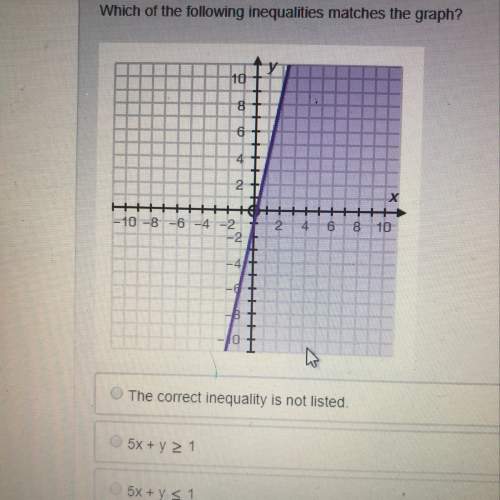
Mathematics, 01.09.2019 04:30 feyundre52
Determine the range of the function in the table below.
x f(x)
-11 50
-13 63
10 -51
21 -72
{-11, -13, 10, 21}
{(-11, 50), (-13, 63), (10, -51), (21, -72)}
{50, 63, -51, -72}
{(50, -11), (63, -13), (-51, 10), (-72, 21)}

Answers: 1


Other questions on the subject: Mathematics


Mathematics, 21.06.2019 17:00, aberiele1998
The table shows population statistics for the ages of best actor and best supporting actor winners at an awards ceremony. the distributions of the ages are approximately bell-shaped. compare the z-scores for the actors in the following situation. best actor best supporting actor muequals42.0 muequals49.0 sigmaequals7.3 sigmaequals15 in a particular year, the best actor was 59 years old and the best supporting actor was 45 years old. determine the z-scores for each. best actor: z equals best supporting actor: z equals (round to two decimal places as needed.) interpret the z-scores. the best actor was (more than 2 standard deviations above more than 1 standard deviation above less than 1 standard deviation above less than 2 standard deviations below) the mean, which (is not, is) unusual. the best supporting actor was (less than 1 standard deviation below more than 1 standard deviation above more than 2 standard deviations below more than 1 standard deviation below) the mean, which (is is not) unusual.
Answers: 1

Mathematics, 21.06.2019 21:00, trinitymarielouis
How do you write y-10=2 (x-8) in standard form
Answers: 1

Mathematics, 21.06.2019 21:30, gonzalezashley152
In a test for esp (extrasensory perception), the experimenter looks at cards that are hidden from the subject. each card contains either a star, a circle, a wave, a cross or a square.(five shapes) as the experimenter looks at each of 20 cards in turn, the subject names the shape on the card. when the esp study described above discovers a subject whose performance appears to be better than guessing, the study continues at greater length. the experimenter looks at many cards bearing one of five shapes (star, square, circle, wave, and cross) in an order determined by random numbers. the subject cannot see the experimenter as he looks at each card in turn, in order to avoid any possible nonverbal clues. the answers of a subject who does not have esp should be independent observations, each with probability 1/5 of success. we record 1000 attempts. which of the following assumptions must be met in order to solve this problem? it's reasonable to assume normality 0.8(1000), 0.2(1000)%30 approximately normal 0.8(1000), 0.2(1000)% 10 approximately normal srs it is reasonable to assume the total number of cards is over 10,000 it is reasonable to assume the total number of cards is over 1000
Answers: 1
You know the right answer?
Determine the range of the function in the table below.
x f(x)
-11 50
-13 63
...
x f(x)
-11 50
-13 63
...
Questions in other subjects:

Mathematics, 30.07.2019 23:00


Health, 30.07.2019 23:00




Mathematics, 30.07.2019 23:00

Mathematics, 30.07.2019 23:00

Social Studies, 30.07.2019 23:00




